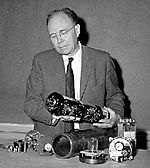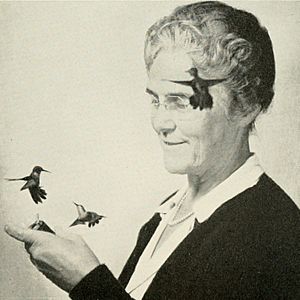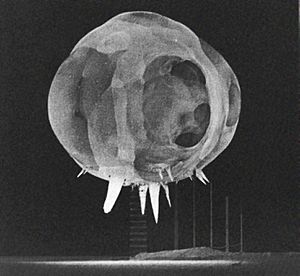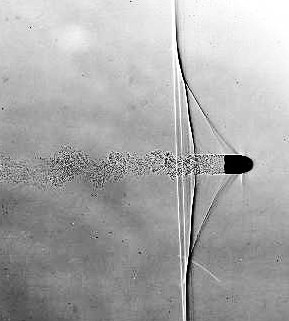Doc Edgerton facts for kids
Quick facts for kids
Harold Eugene Edgerton
|
|
|---|---|

Edgerton in 1963
|
|
| Born | April 6, 1903 |
| Died | January 4, 1990 (aged 86) Cambridge, Massachusetts
|
| Alma mater | University of Nebraska-Lincoln (B.S., Electrical Engineering, 1925) Massachusetts Institute of Technology (M.S., Electrical Engineering, 1927; PhD, Electrical Engineering, 1931) |
| Known for | Stroboscope |
| Awards | SPIE Gold Medal (1981) |
| Scientific career | |
| Fields | Engineering/photography |
| Institutions | Massachusetts Institute of Technology |
Harold Eugene "Doc" Edgerton (April 6, 1903 – January 4, 1990) was an American scientist and professor. He taught electrical engineering at the Massachusetts Institute of Technology (MIT). People also called him Papa Flash because of his amazing work with light.
He is famous for making the stroboscope a common tool. A stroboscope uses quick flashes of light to make fast-moving things look like they are standing still. Doc Edgerton also helped develop sonar and special cameras for deep-sea photography. His equipment was used by famous explorer Jacques Cousteau to find shipwrecks and even search for the Loch Ness Monster.
Contents
Biography
Early Life and Education
Harold Edgerton was born in Fremont, Nebraska, on April 6, 1903. He grew up in Aurora, Nebraska, and also spent time in Washington, D.C., and Lincoln, Nebraska. His father was a lawyer and writer.
In 1925, Edgerton earned a bachelor's degree in electrical engineering from the University of Nebraska-Lincoln. He then went to MIT. There, he earned a master's degree in 1927 and a doctorate in 1931. For his doctorate, he used stroboscopes to study electric motors.

Doc Edgerton was inspired to photograph everyday things using electronic flash. One of his first photos was of water coming from a faucet. In 1936, he helped an expert named May Rogers Webster photograph hummingbirds. He showed how to capture their wings beating 60 times a second with a very fast flash. A picture of her with the birds was even in National Geographic.
Amazing Photography and Inventions
In 1937, Edgerton started working with photographer Gjon Mili. Mili used Edgerton's stroboscopic equipment to create stunning photos, many of which appeared in Life Magazine. This equipment could flash up to 120 times per second!
Edgerton was a pioneer in using short, electronic flashes to photograph very fast events. He captured images of balloons bursting, a bullet hitting an apple, and even the path of a devil stick in motion. His work helped us see things that happen too quickly for the human eye.
He received many awards for his work, including the National Medal of Science in 1973.
Edgerton also started a company called EG&G with his partners. This company became very important for the United States Atomic Energy Commission. EG&G helped photograph and record nuclear tests for the U.S. government. For this, Edgerton and his team created the Rapatronic camera, which could take pictures in less than a millionth of a second.
His work was also key in developing side-scan sonar technology. This technology is used to scan the ocean floor for shipwrecks. Edgerton worked closely with undersea explorer Jacques Cousteau. He designed special underwater cameras with electronic flash for Cousteau. He also developed sonar techniques that helped find the shipwreck of the Britannic. Because of his work with Cousteau, people in photography circles called him "Papa Flash."
In 1940, Edgerton's short film Quicker'n a Wink, which showed his high-speed photography, won an Oscar.
Doc Edgerton became a professor at MIT in 1934. He was very popular with students because he loved to teach and was very kind. He once said, "The trick to education is to teach people in such a way that they don't realize they're learning until it's too late."
In 1962, Edgerton even appeared on a TV show called I've Got a Secret. He showed off his strobe flash photography by shooting a bullet through a playing card and capturing the moment. His work was also featured in a 1987 National Geographic Magazine article titled "Doc Edgerton: the man who made time stand still."
Family Life
In 1928, Edgerton married Esther May Garrett. She was also from Aurora, Nebraska. Esther was a talented pianist and singer. They had three children: Mary Louise, William Eugene, and Robert Frank.
Later Years and Passing
Harold Edgerton remained active even after officially retiring from MIT. He passed away suddenly on January 4, 1990, at the age of 86. He is buried in Mount Auburn Cemetery in Cambridge, Massachusetts.
Legacy
Doc Edgerton's work continues to inspire people. In 1990, people in his hometown of Aurora, Nebraska, decided to build a science center to honor him. The Edgerton Explorit Center opened in 1995. It's a "hands-on" museum where people can learn about science and Doc's amazing inventions.
At MIT, the Edgerton Center was founded in 1992. It's a special lab where students can get hands-on experience. It also runs educational programs for high school students and teachers.
Works
Doc Edgerton wrote several books about his work:
- Flash! Seeing the Unseen by Ultra High-Speed Photography (1939)
- Electronic Flash, Strobe (1970)
- Moments of Vision (1979)
- Sonar Images (1986)
- Stopping Time, a collection of his photographs (1987)
Famous Photographs
Some of Edgerton's most well-known photographs include:
- Milk Drop Coronet (1935)
- Hummingbirds (1936)
- Football Kick (1938)
- Diver (1955)
- Cranberry Juice into Milk (1960)
- Bullet Through Banana (1964)
- .30 Bullet Piercing an Apple (1964)
- Bullet Through Candle Flame (1973)
Exhibitions
Doc Edgerton's work has been shown in many art museums and galleries around the world. These exhibitions help people see the beauty and science in his amazing photographs.
Collections
Edgerton's work is kept in important public collections, including:
- Museum of Modern Art, New York City
- International Photography Hall of Fame, St. Louis, MO
See also
 In Spanish: Harold Eugene Edgerton para niños
In Spanish: Harold Eugene Edgerton para niños
- Air-gap flash



